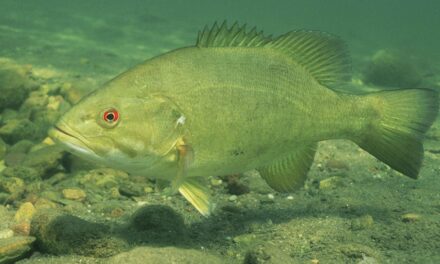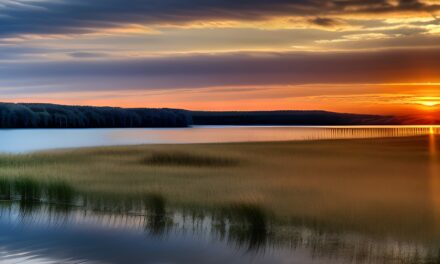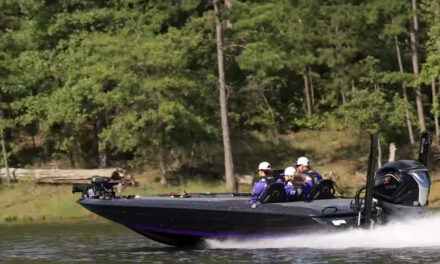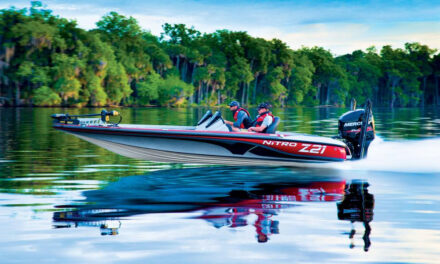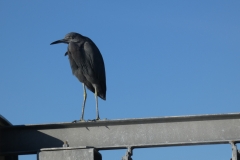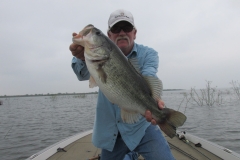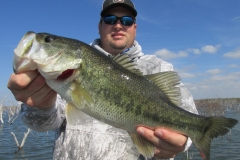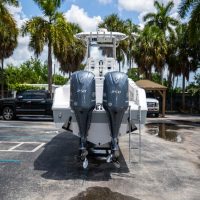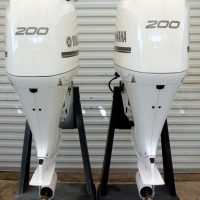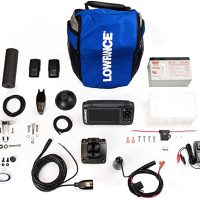It’s summer, the winds have died, the days are unbearably hot, the fishing gets R E E L slow (pardon the pun), and you just have to adjust, so what do the diehards do? You can get an earlier start and take advantage of great topwater action (buzzbaits, spooks, Rogue’s, Pop R’s, Chug Bugs, etc.) until the sun gets up; then, its time to take drastic measures. In lakes with vegetation, you basically have four options: Plunge the grass, drift the mainlake flats and ridges along the edges of creek channels, fish the points or go to the house and get in the air-conditioning until about 8 p.m.! Some lakes don’t have an abundance of vegetation, and in those situations, look for the fish to be suspended over deep water ledges, humps, deep water pond dams or along creek channel edges. The fish will be holding in these areas on cover such as rocks or timber near the deep water. You can also locate the fish under the deeper boat docks; or, possibly find them in the mouths of cuts, guts, drains and old sloughs upriver. Regardless of where you find them, the fishing is going to be slow and methodical and the catching is always iffy at best! If you ask any “grass fishermenâ€, what’s the key answer — without a doubt, it will be PLUNGE THE GRASS. This means, get out your flipping rod, have heavy line on (17-20# test), take a 1 to 1 1/4 oz. bullet weight with a 4-5/0 wide gap flipping hook and rig a Gene Larew Hawg Craw Texas style. Find yourself a grass bed (this time of year these beds are visible on the surface) and look for some unusual features such as cuts, drains or small creeks running through the massive grass beds, points jutting out from the edges, pockets, etc. Position the boat near the area you want to fish, drop the line over the side and vertically fish or flip to the edges or pockets of the grass and work the bait back to the boat. Let the bait hit the bottom, bump it up one or two times and reel it back in and repeat. You may not get many bites, but they are usually good ones! Last summer, plunging the grass was not nearly as productive as using spinning gear, light line and “wacky worm†fishing these same areas. The reason this method seemed to produce more bass was because of lake drawdowns, drought conditions and the disappearance of the normally dense vegetation we were used to fishing. There simply was not as much grass to fish. One of our favorite methods to fish in the summer is to “drift fishâ€. Experience has taught us that in different parts of the country this means different things. Don’t ever ask an Okie if they want to drift fish, it doesn’t even come close to meaning the same thing! Here in Texas, Norman and I point the nose of our Boots Follmar Marine Prostaff Skeeter 210 or 202 into the wind, turn the Yamaha motor towards the wind (if any) and position the boat to drift the mainlake flats and ridges along the edges of the flats and near deep water. The reason for turning the motor towards the wind is to keep the boat drifting parallel to the area your trying to fish with the least amount of effort and trolling motor usage. We usually fish these areas with either a Texas rig, Carolina rig, or “Wacky Worm.†For fishing mainlake points, this time of year we look for long sloping points that extend a great distance out into the deeper water. Look for the dropoffs where the concentrated grass ends and the scattered grass begins. We fish these areas with our same basic arsenal, Texas, Carolina or Wacky rigs. Any or all three of these methods will work even in the hottest part of the day! When fishing lakes without a lot of vegetation, concentrate on finding long underwater points extending way out into the lake but have some sort of breaking cover, i.e., stumps, rocks, fence lines, etc. Use the same rigs as mentioned above and concentrate your efforts on the cover that will be holding the fish. Don’t overlook mainlake humps, deep water pond dams and along the edges of the creeks, creek junctions (where two creeks come together), as they are also good producers this time of year. Get your flipping stick out and use in and around the boat docks with deep water close by. Also look for docks that are older, have X cross members underneath and are set on pilings (not floating docks.) Also avoid docks in the backs of the creeks/coves or in the shallow waters, they usually don’t produce this time of year. Other good indicators are to look for docks that have some evidence of regular fishing use, such as rod holders or fishing rods dangling off the ends. If you can find these docks in areas near deep water, it might be a wise decision to turn on your electronics and look for brush piles off the ends. And if all else fails, get out your Carolina rig or crankbait and you will soon discover the brushy areas. Fish this type of brushy cover very thoroughly as well as under the docks as these are areas that are sure to be holding fish. One other method to try in areas of little vegetation is to go upriver until the lake narrows down into a defined channel and look for cuts, guts, drains and sloughs (“funnel pointsâ€, as our friend John Hope would say). Try the mouths of these areas and look for logjams, stumps, rocks, etc. These are very good areas to fish and are easy to fish. As the day progresses and the heat really sets in, keep a towel in the cooler and ring it out over your head to get your body temperature down, or dip a towel in the lake. It’s not a pretty sight, but it is effective. Drink lots of fluids and pay particular attention to what your body is telling you. If you start feeling dizzy, sick at your stomach, or light headed, get your body heat down quickly, anyway you can. You can always take a quick dip over the side and climb back in and fish awhile longer. Sun stroke or heat exhaustion is no laughing matter and can make for many uncomfortable days after the fishing is over. If the heat gets to be too much, or you just can’t make the fish cooperate, it’s time to go to the house, put your feet up and sit in the a/c and watch fishing shows on TV! Don’t let the dog days get the best of you, learn to take advantage of the many opportunities available and try to stay C O O L!
About The Author
Related Posts
Latest Texas Fishing Guide News
 Deep Winter Bass FishingMaster Deep Water Bass Fishing […]
Deep Winter Bass FishingMaster Deep Water Bass Fishing […] The Crucial Importance of Outboard Motor MaintenanceThe Crucial Importance of Outboard Motor Maintenance […]
The Crucial Importance of Outboard Motor MaintenanceThe Crucial Importance of Outboard Motor Maintenance […] Texas Bass FishingTexas Bass Fishing […]
Texas Bass FishingTexas Bass Fishing […] The Skeeter Boat CompanyThe Skeeter Boat Company a Long, Rich History […]
The Skeeter Boat CompanyThe Skeeter Boat Company a Long, Rich History […] Chasing Bass: A Memorable Adventure on Lake Sam Rayburn, TexasBass Fishing Lake Sam Rayburn Texas […]
Chasing Bass: A Memorable Adventure on Lake Sam Rayburn, TexasBass Fishing Lake Sam Rayburn Texas […]
Main Menu
- Home
- Advertising
- Bass Boats
- Texas Bass Fishing Reports
- Texas Bass Fishing Guides
- Texas Fishing Classifieds
- Texas Fishing News
- Submit News
- Texas Fishing Guide Photos
- Texas Tackle Shop
- Texas Saltwater Fishing Guides
- Texas Saltwater Boats
- Submit Fishing Reports
- Lodging
- Texas Marinas
- Vacation Rentals
- Privacy Policy
- Sitemap
- Contact Texas Fishing Guide
Texas Fishing Guide News Categories
- Boating Safety
- Conservation
- GPS
- Lake Amistad
- Lake Conroe
- Lake Falcon
- Lake Fork
- Lake Sam Rayburn
- Lake Toledo Bend
- Marine Electronics
- News
- Texas Bass Boats
- Texas Bass Fishing
- Texas Bass Fishing Guides
- Texas Bass Fishing News
- Texas Bass Fishing Reports
- Texas Bass Fishing Tackle Reviews
- Texas Bass Fishing Tournaments
- Texas Fishing Guide Videos
- Texas Fishing News
- Texas Off Road
- Texas Parks and Wildlife
- Texas Saltwater Boats
- Texas Saltwater Fishing Guides
- Texas Saltwater Fishing Reports
Latest Texas Fishing Guide Classifieds
- This motor is in good running condition and comes with a 2 years warranty. These engines are well maintained, these…
- This motor is in good running condition and comes with a 2 years warranty. These engines are well maintained, these…
- This motor is in good running condition and comes with a 2 years warranty. These engines are well maintained, these…
- Available in five screen sizes: 4”, 5”, 7”, 9” and 12” High-resolution, SolarMAX display Autotuning sonar Double the CHIRP sonar…
- Has all the bells and whistles, I pilot,hot foot,sonar,side,and down imaging,diamond plated tandem trailer with custom wheels boat cover US…



